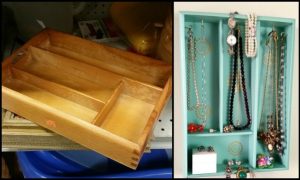Last Updated on January 10, 2025 by teamobn
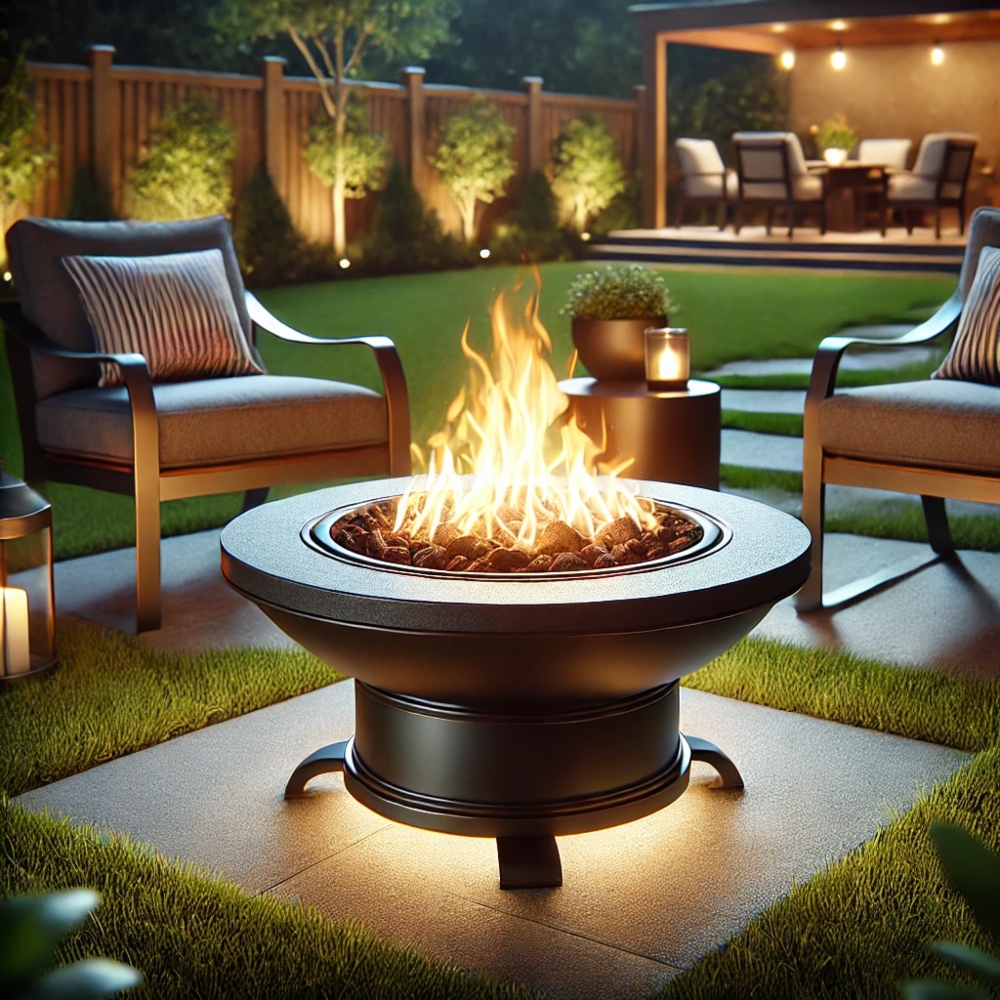
Your garden can become a comfortable haven for a propane fire pit, ideal for relaxing or socializing after a demanding day. Homeowners choose it mostly because of its efficiency and simplicity. Still, utilizing a gas fire pit requires safety precautions to avoid mishaps and guarantee a good experience, as with any outdoor tool. You need to practice the right propane fire pit safety guidelines to ensure everyone will have a good time while getting cozy.
Here we will go over basic safety precautions for utilizing a propane fire pit at home so you may enjoy its warmth and ambiance free from worry.
Contents
Propane Fire Pit Safety Basics
Although a gas fire pit can provide warmth and ambiance to your outdoor area, you must give safety top priority to prevent mishaps and injury. Though generally safe, propane is a volatile gas that should be handled carefully. Learn propane fire pit safety rules before lighting your fire pit to guarantee a safe and fun experience.
Ignoring advice on propane fire pit safety could have serious repercussions risking your property and well-being. The possibility of fire threats is among the most important ones.
Placing the fire pit too near flammable objects or buildings could lead to uncontrollable flames, therefore damaging a lot of property. Ignited leaks in the propane connections might produce gas accumulation, which might result in explosions if undetectable. These situations underline the need of careful venue choice and exhaustive pre-use examination.
Personal injuries constitute still another main hazard. Burns or other injuries might result from mishandled or broken equipment. Particularly vulnerable around fire pits are children and dogs; lack of supervision can lead to mishaps.
Furthermore, neglect of the fire pit might cause it to deteriorate, raising the possibility of malfunction. Ignoring emergency plans with a fire extinguisher or first aid expertise will make things worse. Following safety rules helps you to reduce these hazards and guarantees a good and fun experience.
Choosing the Right Location
Ensuring safety and functionality depends on your propane fire pit’s proper location. Your fire pit’s performance and the safety of your outdoor area can be much affected by its location. These important factors should help you determine where to place your propane fire pit.
Level and Solid Surface
Make sure the ground upon which your gas fire pit rests is level and steady. An uneven surface might allow the fire pit to topple over, therefore increasing the possibility of mishaps. Excellent choices for a strong base are concrete patios, pavers, or especially created fire pit pads. Grassy areas or wooden decks should not have the fire pit placed there since these could be more likely to catch fire.
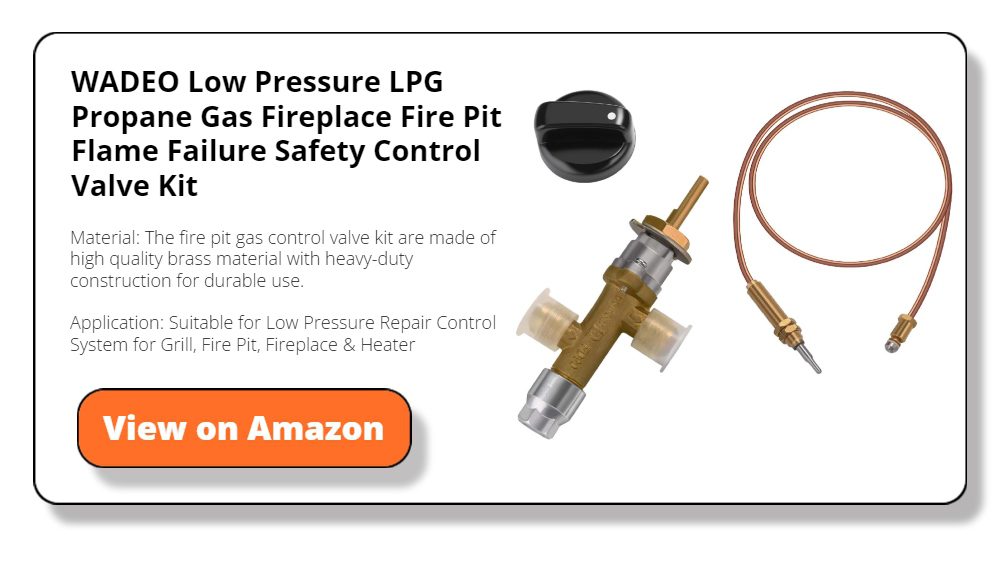
Safe Separation from Buildings
Keep a safe distance between your propane fire pit and any buildings, including your garage, shed or house. Ten feet or more is advised as a minimum distance to stop heat damage or fire spread to adjacent structures. To further reduce fire hazards, keep the fire pit clear of overhangs, low-hanging branches, or other combustible objects.
Enough ventilation
Safety of a propane fire pit depends on proper ventilation. Make sure the fire pit’s surrounding open area is sufficient to let ample airflow. This helps stop propane gas from accumulating, which, should it ignite, might cause dangerous circumstances. Steer clear of utilizing the fire pit in enclosed areas like covered patios or tents where airflow is constrained.
Easy access and convenience
Think about the location’s accessibility and conveniences. Put your gas fire pit in a spot that is easily maintained and accessed. Make sure the route to the fire pit for maintenance and replenishment is unobstructed. Position chairs also at a safe distance from the fire pit so that they may be used comfortably and pleasantly while also preserving safety.
Your propane fire pit’s location will greatly affect the useful, safe, and exciting outdoor space you create. Correct placement guarantees that you will be able to completely enjoy the warmth and atmosphere of your fire pit and lowers your chance of mishaps.
Proper Installation and Setup
Proper installation and configuration are crucial for the safe and effective operation of your fire pit. Proper setup can improve your fire pit’s efficiency and lower the danger of mishaps. Use these instructions to guarantee the correct installation of your propane fire pit.
Read the manufacturer’s directions.
Read the manufacturer’s directions completely before laying your fire pit. Every model could have particular needs and instructions to guarantee safe functioning that have to be followed. Important construction, positioning, and safety tips catered to your particular fire pit will be found in the directions.
Check correct ventilation.
Building your fire pit calls for enough ventilation. Good ventilation lets propane gas distribute properly, therefore preventing the accumulation of gas that can cause explosions. Make sure the fire pit’s surrounds are open and well-ventilated. Steer clear of utilizing the fire pit on a screened porch or beneath a gazebo in partially or completely enclosed areas.
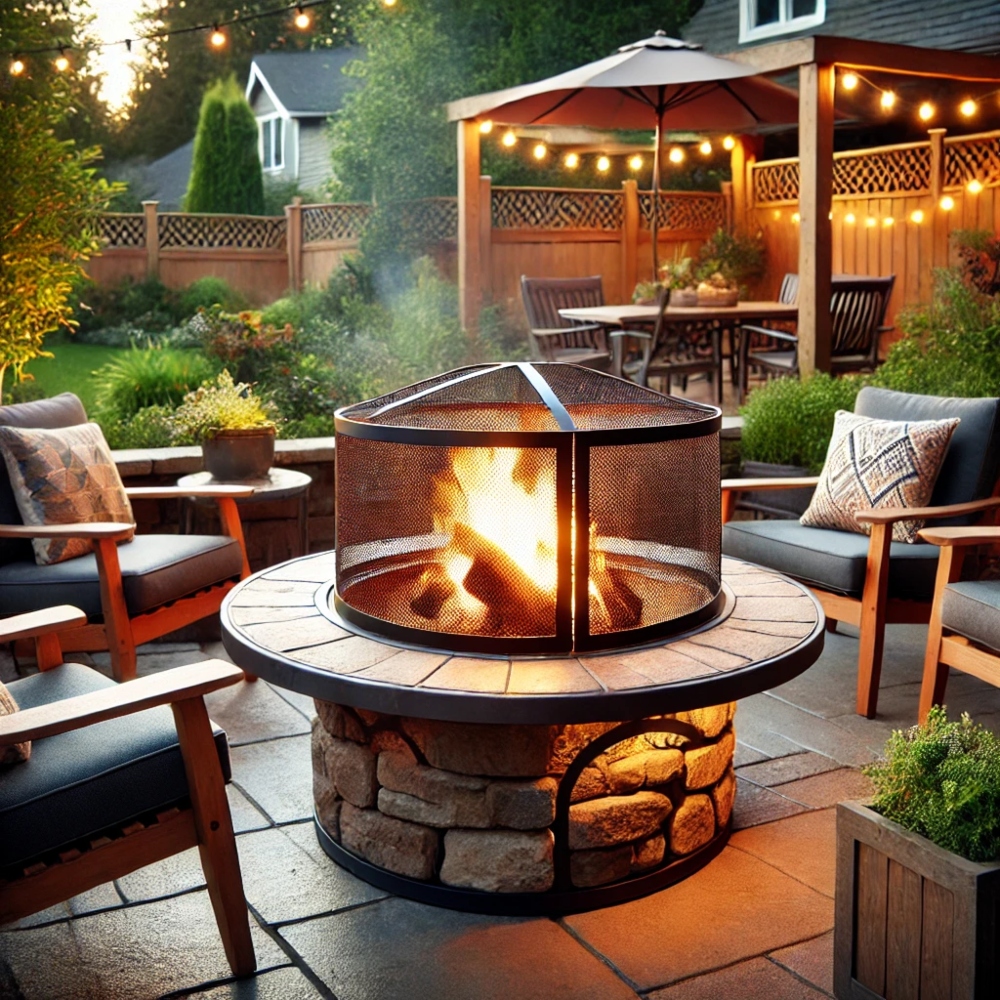
Look for leaks in connections.
Look over all the connections for leaks before lighting your first-time fire pit. Test the connections with soapy water; a leak will show up if bubbles develop. Retest till no bubbles show by tightening any loose connections. This stage is essential to stop gas leaks, which might lead to potentially fatal conditions.
Guard the propane tank.
Proper fastening of the propane tank is crucial for safe operation. The tank must be fixed to prevent tipping and laid on a level, steady surface. A regulator is required to control gas flow from the tank to the fire pit. Frequent tank and regulator connection checks help guarantee their security and proper operation.
Create a Propane Fire PIt Safety Check.
Before utilizing your fire pit, thoroughly check for safety. Check that every component is in good shape and correctly assembled. Make sure the fire pit is clear from flammable objects and that area is clearly defined around it. As a precaution, keep a fire extinguisher close-by.
These guidelines will help you to guarantee that your propane fire pit is put up securely. Enjoying the warmth and atmosphere of your fire pit without sacrificing safety depends mostly on good installation and setup.
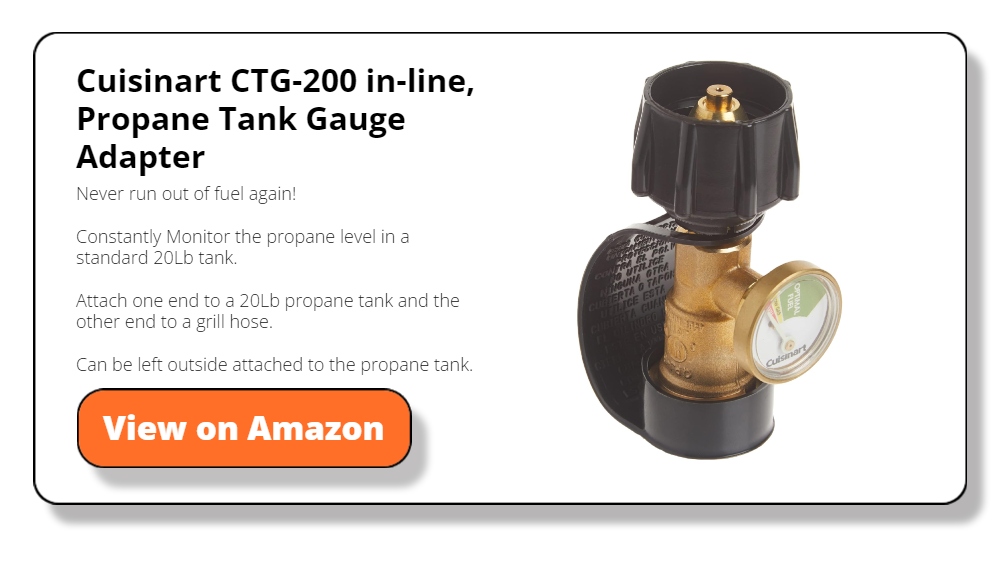
Propane Fire Pit Safety Operation Practices
Safe operation of your fire pit guarantees that you can enjoy its warmth and ambiance without running any danger of mishaps or injury. Maintaining a safe surroundings for everyone depends on following safe operating guidelines. Using your gas fire pit should follow these simple basic rules.
Ignition Procedures
Lighting your gas fire pit according to manufacturer’s ignition instructions always comes first. Usually, this is opening the gas valve and running an ignition switch or lighter meant for fire pits. Use only normal lighters or matches; these can be dangerous. Before lighting, be sure the gas flow is constant and steady.
Track the Flame.
Watch the flame constantly once your propane fire pit is lit. The blue, constant flame should indicate effective burning. Should the flame be yellow or flickering, this could point to a burner or propane flow problem. Never leave the fire pit alone while in use; change the flame as necessary.
Keep pets and children at a safe distance.
Keep kids and dogs apart from the fire pit to avoid mishaps. Create a safety zone around the fire pit and guarantee constant adherence to it. Teach youngsters about the risks associated with fire and properly monitor them when the fire pit is in use. Additionally kept away should be pets to prevent burns or damage.
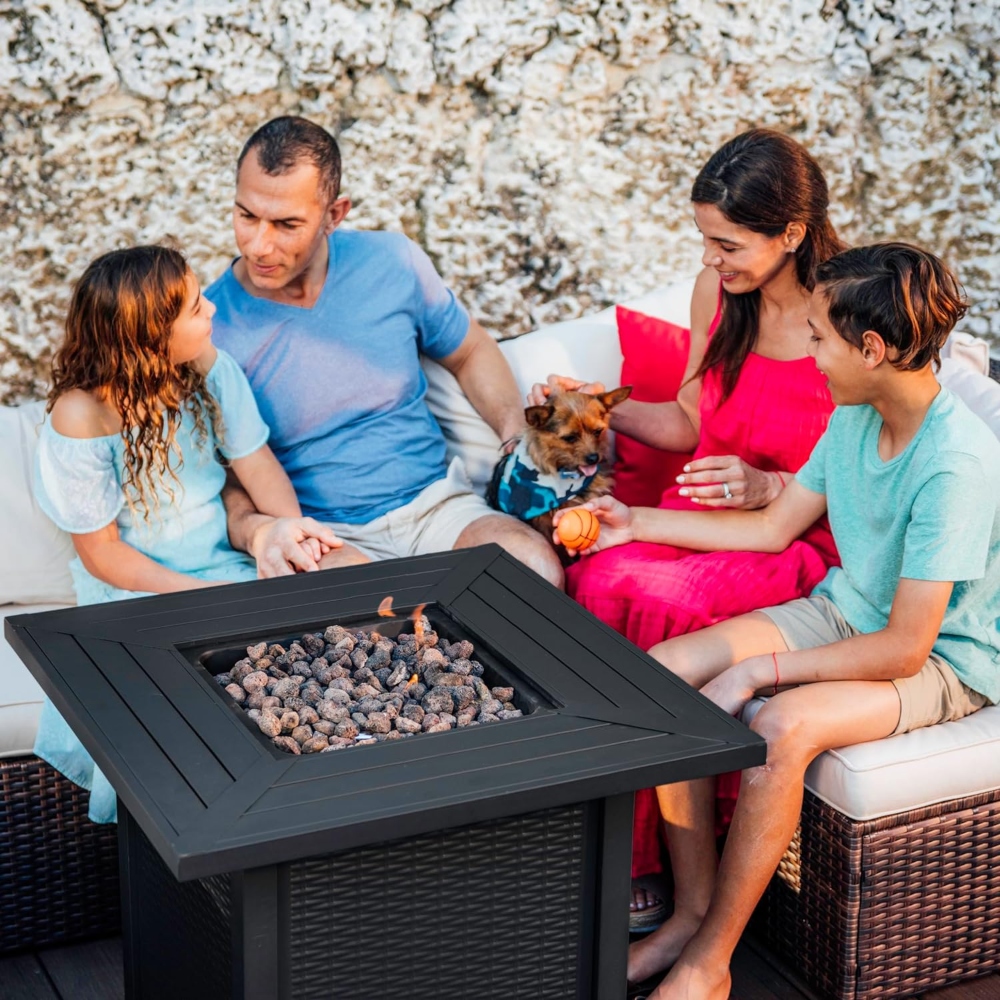
Steer Clear of Accelerators
Start or intensify the flames in your propane fire pit never use accelerants, such gasoline or lighter fluid. Unchecked fires and explosions can be brought on by these compounds. Make only use of the manufacturer’s specified propane fuel source and ignite mechanism.
Notes about Wind Safety
Use your gas fire pit under careful consideration of windy situations. Wind can extinguish a flame and cause it to expand randomly, hence producing gas accumulation. If it is too windy, wait until the conditions calm before using your fire pit. As much as you can, shield the fire pit from significant winds.
Close Down Rightly
Use the correct shutdown techniques after your propane fire pit is done running. Turn off the gas valve, let the fire pit cool totally, then cover or store it. Making sure the fire pit is correctly closed saves propane and helps to avoid inadvertent re-ignition.
Following these safe operating guidelines will help you to enjoy your gas fire pit without doubt. Your first concern should always be safety so that your visitors and you may have a good and risk-free experience.
Maintenance and Inspection
Regular maintenance and inspection are crucial to ensuring the safe and efficient operation of your propane fire pit. Keeping your fire pit in good condition not only enhances its performance but also extends its lifespan. Here are key maintenance and inspection practices to follow.
Regular Cleaning and Upkeep
To maintain your propane fire pit, clean it regularly to prevent the buildup of dirt, debris, and soot. Use a soft brush or cloth to wipe down the exterior surfaces. For the burner and ignition system, follow the manufacturer’s instructions for cleaning. Removing accumulated debris ensures proper gas flow and prevents blockages that could affect performance.
Inspecting Components for Wear and Damage
Regularly inspect all components of your propane fire pit for signs of wear and damage. Check the burner, ignition system, and gas lines for any cracks, corrosion, or other issues. Look for rust or other signs of deterioration on the exterior. If you notice any damage, replace the affected parts immediately to maintain safe operation.
Checking for Gas Leaks
Periodically check for gas leaks to ensure the safety of your propane fire pit. Use a soapy water solution to test all gas connections. If bubbles form, there is a leak. Tighten the connections and retest until no bubbles appear. Consistent leak checks prevent potential gas buildup and the associated risks.
Replacing Propane Tanks Safely
When it’s time to replace the propane tank, follow proper safety procedures. Turn off the fire pit and disconnect the old tank. Inspect the new tank for any damage before connecting it. Ensure all connections are secure and check for leaks using the soapy water solution. Proper handling and replacement of propane tanks are essential to prevent accidents.
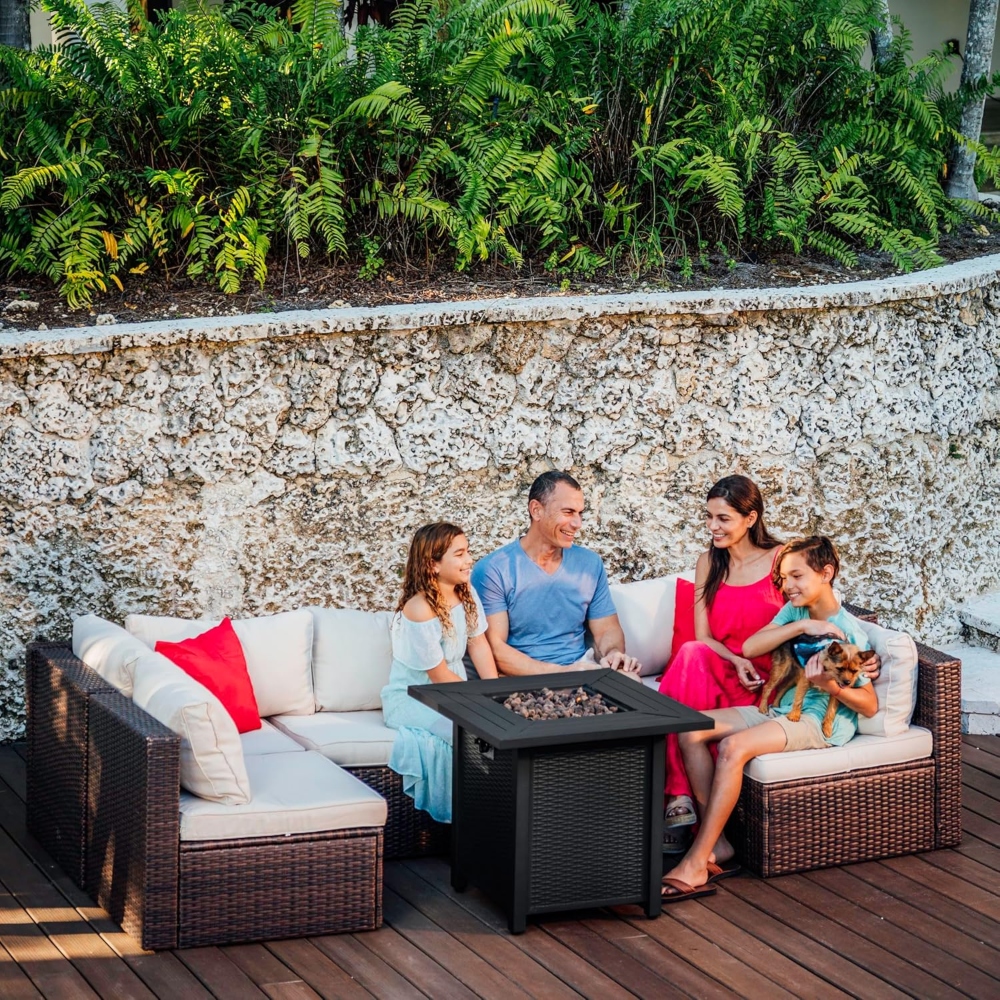
Storing Your Propane Fire Pit
Proper storage of your propane fire pit when not in use is vital for its longevity and safety. Store the fire pit in a dry, covered area to protect it from the elements. If you are storing the propane tank separately, ensure it is in a well-ventilated area away from direct sunlight and heat sources. Safe storage practices help maintain the condition of your fire pit and propane tank.
Schedule Professional Inspections
Consider scheduling professional inspections for your propane fire pit, especially if you use it frequently. A professional can identify and address issues that might not be visible during regular inspections. This ensures that your fire pit remains in optimal condition and operates safely.
By adhering to these maintenance and inspection practices, you can keep your propane fire pit in top condition. Regular upkeep and careful inspection significantly reduce the risk of malfunctions and extend the life of your fire pit, allowing you to enjoy it safely for years to come.
Emergency Preparedness
Using your gas fire pit properly depends critically on your being ready for an emergency. Although most problems may be avoided with good maintenance and operation, knowing how to handle unanticipated events helps reduce hazards and guarantee the general safety of all the engaged parties.
Below are the emergency guidelines to consider:
Maintaining a Fire Extinguisher Closeby
Use your propane fire pit always with a fire extinguisher close at hand. Make sure it’s a Class B extinguisher, fit for gas flames. Learn how it works and then arrange it in a convenient spot. To be sure the extinguisher is completely charged and in operating order, often check it.
Learn How to Cut off the Gas Supply.
Quickly turning off the gas supply in an emergency can help to avoid a minor problem from becoming a large one. Learn where and how to find the gas valve on your propane fire pit. Learn to turn it off so that, were necessary, you can do it quickly. Make sure everyone living in the house understands how to stop the gas supply.
First Aid for Injuries and Burns
Using a propane fire pit calls for an awareness of fundamental first aid for burns and other ailments. Arrange a first aid package close by with bandages, sterile gauze, and burn ointment among other basics. If you have small burns, chill the afflicted region for several minutes under running water then apply burn ointment. See a doctor right away for more major injuries.
Create a Clear Safety Zone.
Clearly defining a safety zone around your gas fire pit can help to avoid mishaps and enable quick reactions in case of crisis. Make sure additional flammable objects, decorations, and furniture are stored safely apart. Tell guests—especially young children—of the safety limits. This step serves to keep the space free for fast evacuation and emergency reaction.
Create an emergency strategy.
Make a thorough emergency plan for your residence with particular steps for propane fire pit situations. This strategy should cover actions for extinguishing flames, turning off the gas supply, providing first aid, and phoning emergency services. Review and rehearse this strategy often with every household member to make sure everyone knows what to do in an emergency.
Keep Up With Weather Conditions
Check the weather before utilizing your propane fire pit. Strong winds or dry conditions could raise the possibility of fire spreading. It would be advisable to postpone utilizing the fire pit if bad weather is anticipated. Maintaining knowledge lowers the possibility of emergencies and enables you to make wise decisions.
These steps of emergency readiness will help to guarantee a safer surroundings for operating your gas fire pit. Being ready to handle crises not only shields you and your family but also lets you enjoy your fire pit with peace of mind.
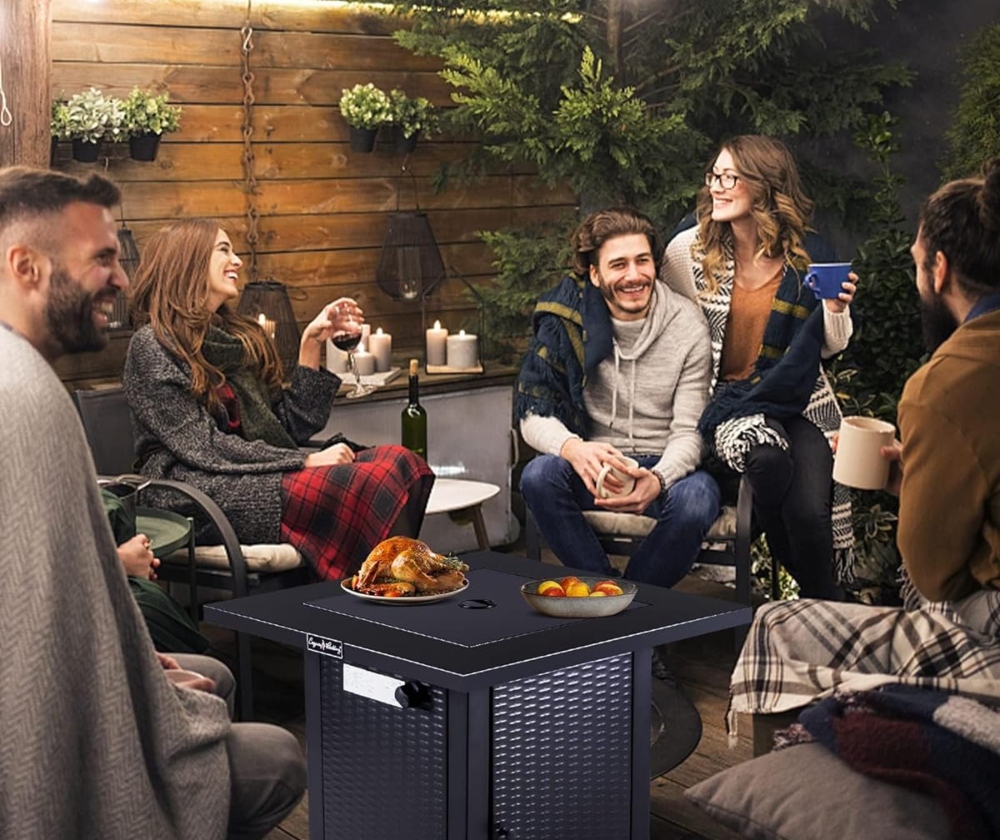
Storing Your Propane Fire Pit
Maintaining the quality of your propane fire pit and guaranteeing safety depend on proper storage of it while not in use. Following the proper storage techniques will extend the lifetime of your fire pit and maintain the safety of your outdoor area whether you are storing it for a brief period or during the off-season.
These are some important pointers on efficiently storing your propane fire pit.
Cool Before Storage
Make sure your propane fire pit has cooled totally before storing it. Move or cover the fire pit never when it is still hot. Give enough time for every component to cool so as to prevent possible burns and heat damage to storage items.
Thoroughly clean.
Before you store your propane fire pit, completely clean it. Using a brush and light detergent, clear the fire pit of trash, ashes, or soot. Cleaning helps to avoid the accumulation of corrosive materials that might, over time, compromise the fire pit. Make sure everything dries before you store it to prevent rust and mold.
Cut and Store the Propane Tank
Always separate the propane tank from the fire pit before storage for safety concerns. Store the propane tank away from direct sunlight, heat sources, and flammable materials in a well-ventilated place. To stop gas leaks, guarantee the tank valve is completely closed. Storing the tank outdoors in an upright posture can help to prevent any possible risks.
Use protective covers.
Put money on a premium protective cover for your propane fire pit. When not in use, a cover shields the fire pit from elements, including dust, moisture, and weather. To give best protection, make sure the cover fits tightly and firmly over the fire pit. To provide even more protection from the elements, if at all feasible place the covered fire pit in a sheltered area, like a shed or garage.
Store in a Dry, Safe Area.
Store your propane fire pit somewhere dry and safe. Steer clear of places likely to be moist or subject to significant temperature swings since these factors can harm. Store the fire pit outside on a level, raised platform to stop water from gathering around it.
Often Check Stored Fire Pit
Periodically check your stored gas fire pit to make sure it stays in good shape while if not usage. Look for any damage, moisture accumulation, or bug infestations. Take quick care of any problems to stop long-term damage.
Organize for seasonal maintenance.
Think about seasonal maintenance before winter or off-season storage of your propane fire pit. This covers verifying all connections are tight, lubricating moving parts, and looking over all parts for wear and tear. Before storage, good maintenance helps find and resolve possible problems so your fire pit is ready for use once the season arrives.
Following these storage guidelines will help you keep your gas fire pit in great shape, ready to offer warmth and ambiance whenever needed. Good storage techniques not only increase the lifetime of your fire pit but also guarantee the safety of your outside area.
Conclusion
Following safety recommendations for your propane fire pit is crucial for a safe and fun experience. Proper location, installation, operation, maintenance, and emergency readiness are also important for preventing mishaps. These safety measures will allow you to boldly enjoy the coziness and atmosphere of your fire pit.
FAQ: Propane Fire Pit Safety
- How often should I clean my gas or propane fire pit?
- Regular cleaning of your gas or propane fire pit ensures safety and extends its lifespan. After each use, wipe down the surfaces to prevent residue buildup. Conduct weekly inspections to remove debris or grime, even though these models produce less mess than wood-burning fire pits.
- Perform a monthly deep clean by disconnecting the fuel source and thoroughly cleaning the burner, ignition system, and surrounding areas. Adhering to this schedule keeps your fire pit in optimal condition for every gathering.
- Why is professional installation important for fire pit safety?
- Professional installation significantly enhances fire pit safety and longevity. Experts ensure safe placement, use appropriate materials, and follow correct techniques to meet safety standards.
- They handle fuel connections properly, preventing leaks or malfunctions that could pose dangers. Additionally, professionals minimize installation errors and ensure compliance with local building codes, protecting you from fines or modifications. Opting for professional installation safeguards your home and family while allowing you to enjoy your fire pit worry-free.
- What are the benefits of having a well-organized space around the fire pit?
- A well-organized area not only enhances safety but also improves the aesthetic appeal of the outdoor space by minimizing clutter.
- How does overcrowding affect safety and movement?
- Overcrowding can hinder people’s ability to move freely and safely, increasing the risk of accidental contact with the fire pit.
- Why should I keep the area around the fire pit clear of excessive furniture and decorations?
- Keeping the area open around the fire pit reduces the chance of accidents and allows for quick movement in case of an emergency.

